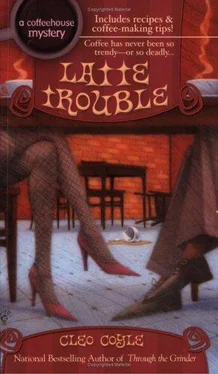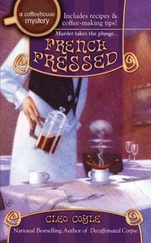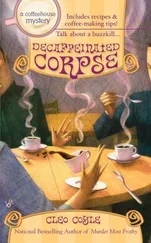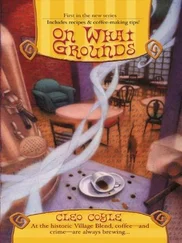Клео Коул - Latte Trouble
Здесь есть возможность читать онлайн «Клео Коул - Latte Trouble» весь текст электронной книги совершенно бесплатно (целиком полную версию без сокращений). В некоторых случаях можно слушать аудио, скачать через торрент в формате fb2 и присутствует краткое содержание. Год выпуска: 2005, ISBN: 2005, Издательство: Berkley, Жанр: Детектив, на английском языке. Описание произведения, (предисловие) а так же отзывы посетителей доступны на портале библиотеки ЛибКат.
- Название:Latte Trouble
- Автор:
- Издательство:Berkley
- Жанр:
- Год:2005
- ISBN:978-0425204450
- Рейтинг книги:3 / 5. Голосов: 1
-
Избранное:Добавить в избранное
- Отзывы:
-
Ваша оценка:
- 60
- 1
- 2
- 3
- 4
- 5
Latte Trouble: краткое содержание, описание и аннотация
Предлагаем к чтению аннотацию, описание, краткое содержание или предисловие (зависит от того, что написал сам автор книги «Latte Trouble»). Если вы не нашли необходимую информацию о книге — напишите в комментариях, мы постараемся отыскать её.
Latte Trouble — читать онлайн бесплатно полную книгу (весь текст) целиком
Ниже представлен текст книги, разбитый по страницам. Система сохранения места последней прочитанной страницы, позволяет с удобством читать онлайн бесплатно книгу «Latte Trouble», без необходимости каждый раз заново искать на чём Вы остановились. Поставьте закладку, и сможете в любой момент перейти на страницу, на которой закончили чтение.
Интервал:
Закладка:
I crossed my arms. “And I suppose you had that little talk? About Joy’s questionable friends and their drug use?”
Matteo looked away. “I didn’t have time. She said she was running late…”. He could see the doubt in my eyes. “Clare, honestly, I can explain—”
“Forget it.”
“Come on, it’s almost closing time. Give me a break.”
“I was stupid to have ever thought you’d change,” I shot back. But I didn’t really think myself stupid. I’d been smart—smart enough to have protected my heart from Matt. Smart enough to have already guessed this would happen.
“Clare!” he called as I strode away. But I just kept walking.
Nineteen
The next day was Saturday. I opened the shop, greeting the baker’s Yankee-jacketed delivery boy and my first customers of the morning in a near-robotic state. I couldn’t stop thinking of Tucker. I had run out of leads. Even worse, my own decidedly less than brilliant theory about Tad and the late Rena Garcia being the guilty parties now lay on the ash heap of history. I could not have been more wrong about the ill-fated couple, who were not suspects, but victims.
The morning rush came and went, the mail arrived, and I pulled espressos, mixed lattes and cappuccinos by rote. By eleven, Detective Quinn was too busy to return my calls—presumably because he was diligently tracking down the elusive fashion designer Fen. Matteo was off and running on his coffee kiosk planning. And Rena’s killer was still on the loose. Then, as I was preparing for the early lunch rush, a bicycle messenger arrived with a hand-delivered package.
“Are you Clare Cosi?”
I nodded and he offered me a clipboard. “Sign here…and print your full name here.”
I scribbled my name, then wrote it out in block letters. The man handed me a manila envelope; the return address read “Tanner and Associates, Attorneys-at-law.” The address was on Madison Avenue. Noting the delivery, Esther Best appeared at my shoulder.
“What is it? Good news I hope.”
“Something from Tucker’s lawyer, I think.”
I ripped into the envelope and found a letter and another envelope inside—this one from the Deputy Commissioner of Corrections, the New York City Department of Corrections.
“Be advised that this authorized pass allows Ms. Clare Cosi and Mrs. Blanche Dreyfus Allegro Dubois to visit prisoner #3244798909, Mr. Tucker Burton of—”
I ceased reading because Esther Best was whooping and woofing (a hip-hop generation thing) and drawing the attention of several patrons. “When are you going?” she cried.
“As soon as I can,” I said, closing my eyes in grateful relief.
I quickly climbed the back steps and entered my small, second floor office to call Madame. I had been trying without success to arrange a visit with Tucker since his arrest, never imagining how difficult it could be to visit someone once he was incarcerated in what amounted to America’s only penal colony . Unless you’re a relative, it’s nearly impossible to visit a prisoner on Rikers Island, and even then you can only see the inmate if they’ve put your name on an official list kept at the prison. For everyone else, save legal council or members of law enforcement, a request for a visit must be sent to the Deputy Commissioner of Corrections, who receives between 1,500 and 2,000 such requests every month. Typically it takes weeks to receive a reply, usually in the negative.
I’d mentioned the problem to Matteo, who passed the information on to Breanne. Somehow Ms. Summour’s lawyer had managed to cut through the mountain of bureaucratic red tape and the authorization magically had appeared. Though I was no fan of Breanne Summour, at the moment, I was truly grateful for the pass, and I knew Madame would feel the same.
I dialed her number and Madame answered on the second ring. “It’s the maid’s day off, my dear,” she explained. I told her the wonderful news and Madame was as ecstatic as I was.
“I’ll be over in an hour,” I told her.
Fifty-two minutes later, I flagged a cab on Hudson, climbed in, and told the driver my destinations. “First I need to pick up someone on Fifth near Washington Square Park. Then we’ll be going on to Rikers.”
The driver did a double take, his dreadlocks flying as he turned his head. “Rikers? Mon, you mean the prison?” he said in a lilting Caribbean accent. He shook his head, his dreads taking flight again. “Lady, I don’t even know how to get there. It’s in Queens, no?”
“Yes, it’s on the north shore of Queens—in the middle of the East River.”
“Well, lady, this cab, she don’t float. So I’m gonna have to call my dispatcher.” While the driver headed over to Washington Square, I pulled out my cell and rang Madame.
“Apparently, cabbies don’t know how to get to Rikers Island,” I explained.
“Never mind, dear. I’ll call my own car service. I’m sure Mr. Raj can help us out.”
I informed the cab driver I’d be getting out at Washington Square, and to forget the trip to Rikers. He seemed relieved. On Fifth, I found Madame waiting for me on the sidewalk in front of her building. She was wrapped in an elegant belted, pecan brown coat with faux fur trim on the cuffs, lapels, and turned up collar.
“Mr. Raj insisted on driving us himself. He’s made the trip before.”
My eyebrows went up. “Did he tell you why?”
She waved her hand. “I did not ask and he did not offer.”
A few minutes later, a black late-model Lincoln town car with bright white Taxi and Limousine Commission plates pulled up to the sidewalk. A diminutive middle-aged man with cocoa-brown skin and a thick iron-gray moustache stepped out and opened the door for us.
“ Bonjour , Mr. Raj,” said Madame sweetly.
“ Bonjour , Madame,” he replied to my French-born ex-mother-in-law. Smiling behind his moustache, he wore a well-tailored suit and a deep blue turban.
The ride out of Manhattan was fairly uneventful. We headed uptown and through the Queens Midtown Tunnel, then onto the Grand Central Parkway. As we approached LaGuardia Airport, however, the driver swerved onto a rarely used ramp marked Nineteenth Avenue. The ramp led to a narrow two-lane bridge, the only route to Rikers Island without a boat.
The bridge, largely unknown to most New Yorkers, stretched more than a mile across the East River. As we drove across the fast-moving water, a deafening roar sounded around us and the silver wings and fuselage of a United Airlines plane appeared over our heads. It rapidly descended, flying so low its roaring engines rattled our car windows and I could almost make out passengers in their upright and locked positions. For a moment, my heart stopped—I was certain I was witnessing a passenger airplane crash. Then I noticed the pier on our right displaying a huge sign directing pilots to LaGuardia’s runway 13-31. Seconds later, the jet smoothly touched down.
I sighed and sat back. Outside the car’s tinted windows, the sunlight played on the rippling waters of the East River. The route over the bridge was a lonely one, patrolled by officers in cars and on foot. Along the way, posted signs warned passengers that firearms, cameras, and photographic devices, tape recorders, beepers and cell phones, and a host of other items were not permitted inside the prison and would be confiscated; that proper identification would be required; and that all visitors were subject to a physical search before entering the sprawling island compound.
During the drive from Manhattan to Queens, I read to Madame from some papers the lawyer had provided, learning the information myself as I read. Apparently the island was named after the Rikers family, who’d sold the giant piece of rock rising from the East River to New York City in the 1880s. The city initially used the land as a dump. Over the next forty-plus years, the size of the land mass quadrupled, a result of the thousands of tons of refuse deposited there. By 1935, the dump was closed and the garbage barges halted as the first jail opened. The Rikers Island Correctional Facility is now one of the largest prisons in the world, comprised of ten jails spread across an area half the size of Central Park. There are nine jails for men and one for women, and the entire place has a daytime population of close to twenty-thousand people including prisoners, employees, and visitors.
Читать дальшеИнтервал:
Закладка:
Похожие книги на «Latte Trouble»
Представляем Вашему вниманию похожие книги на «Latte Trouble» списком для выбора. Мы отобрали схожую по названию и смыслу литературу в надежде предоставить читателям больше вариантов отыскать новые, интересные, ещё непрочитанные произведения.
Обсуждение, отзывы о книге «Latte Trouble» и просто собственные мнения читателей. Оставьте ваши комментарии, напишите, что Вы думаете о произведении, его смысле или главных героях. Укажите что конкретно понравилось, а что нет, и почему Вы так считаете.












